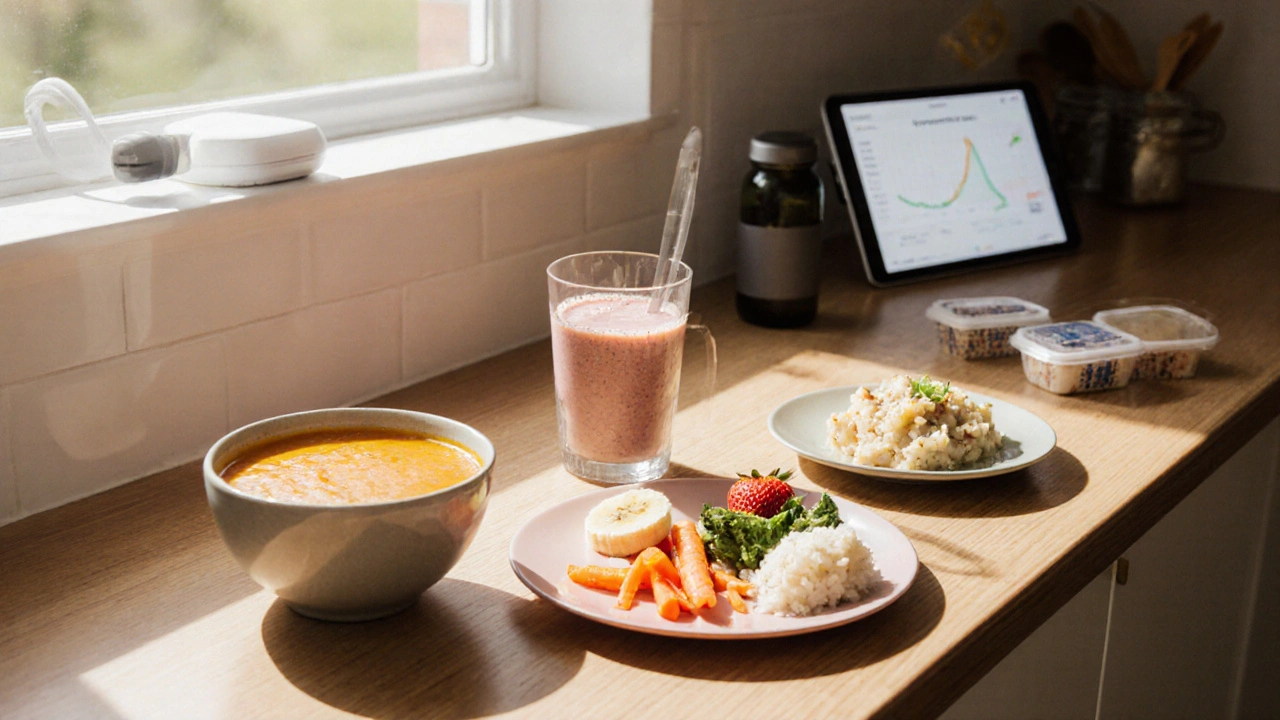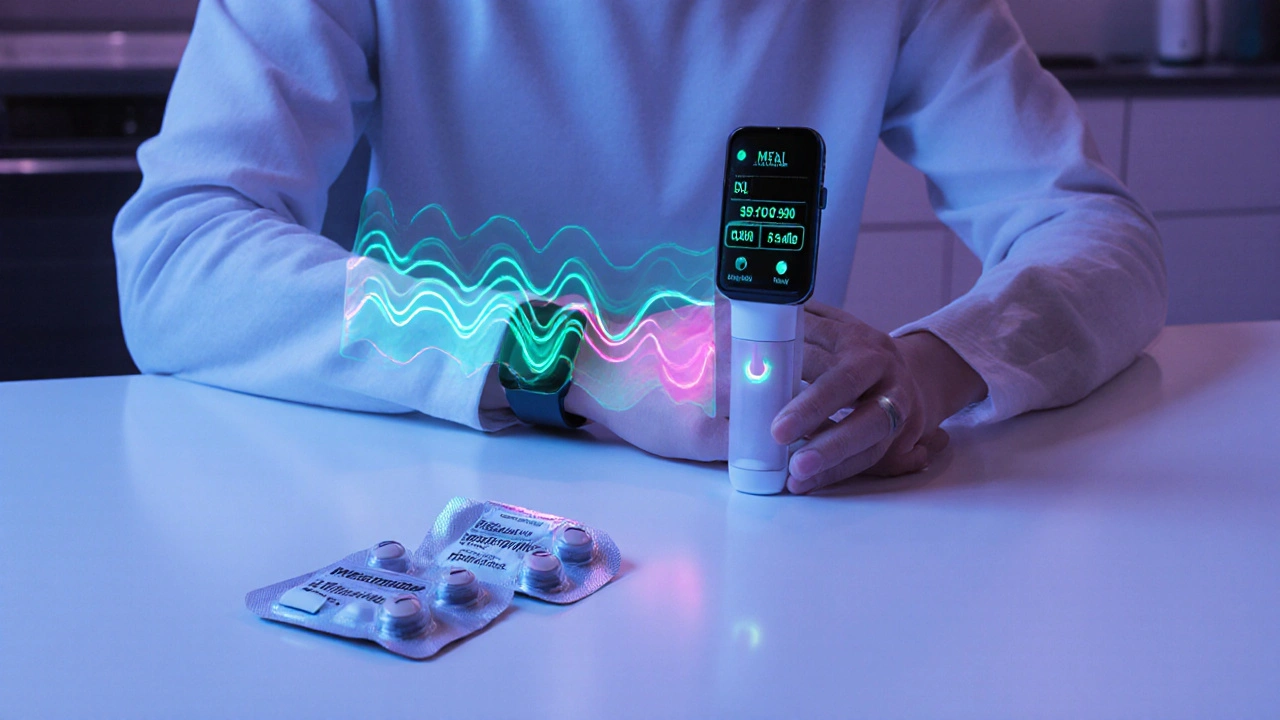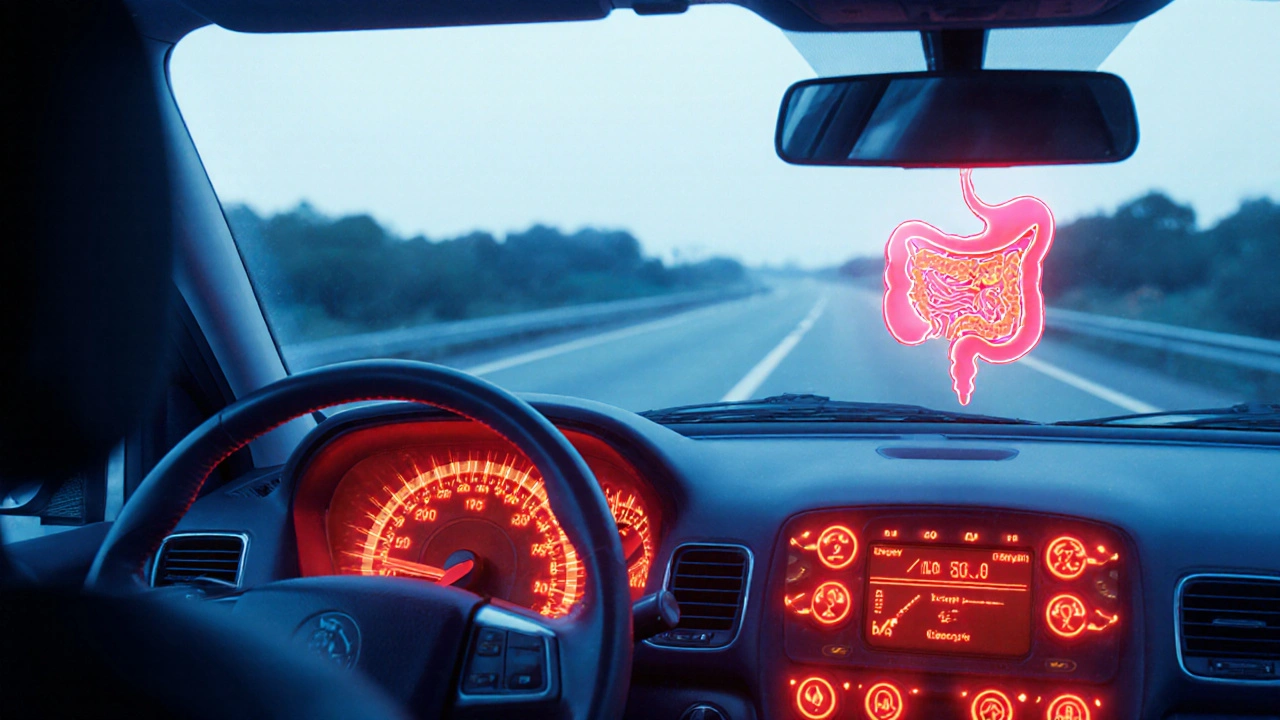Diabetic Gastroparesis Meal Planner
Your Personalized Meal Plan
Based on your inputs, here's a recommended approach to manage your gastroparesis symptoms:
- Eat main carb sources earlier in the day
- Avoid high-fat and high-fiber foods
- Consider smaller, more frequent meals
- Keep a daily log of symptoms and glucose patterns
- Consider using a CGM for real-time monitoring
- Re-evaluate your plan every 4 weeks
Living with diabetic gastroparesis feels like trying to steer a car with a stuck accelerator - your blood sugar jumps, drops, and the dashboard lights keep flashing. The good news is that with the right blend of diet tweaks, medication tricks, and tech tools you can tame the delays and keep glucose numbers steady.
What Is Diabetic Gastroparesis?
Diabetic gastroparesis is a chronic condition where high blood sugar damages the nerves that control stomach muscles, leading to slowed or irregular gastric emptying. It’s most common in people who have lived with type 1 or long‑standing type 2 diabetes for over a decade. Studies from the American Diabetes Association estimate that about 5‑10% of diabetics develop noticeable symptoms such as nausea, early satiety, and unpredictable blood glucose spikes.
How Delayed Stomach Emptying Messes With Blood Sugar
When the stomach holds food longer than normal, carbs are released into the bloodstream at irregular intervals. This creates two dangerous patterns:
- Post‑prandial hyperglycemia - a sudden surge as a large glucose load finally hits the small intestine.
- Late‑onset hypoglycemia - a drop hours later when insulin, already in the system, meets a delayed glucose influx.
In addition, the feeling of fullness can make patients skip meals or over‑eat later, further destabilizing glucose readings.
The Three Pillars of Success
Managing the condition boils down to three inter‑linked pillars: diet, medication, and monitoring technology. Each pillar feeds the others, so neglecting one weakens the whole system.

Dietary Strategies That Really Work
Low‑fiber diet is a nutrition plan that limits insoluble fiber which slows gastric emptying even further. While fiber is generally heart‑healthy, in gastroparesis it can become a roadblock. Instead, aim for:
- **Small, frequent meals** - 5‑6 mini‑meals spread over 12‑14 hours keep the stomach from overloading.
- **Pureed or soft textures** - soups, smoothies, and well‑cooked veggies reduce the mechanical work the stomach must perform.
- **Balanced macronutrients** - pair carbs with protein and a modest amount of healthy fat to blunt glucose spikes.
- **Avoid high‑fat, high‑fiber foods** - fried foods, raw cruciferous vegetables, and whole‑grain breads are best saved for days when symptoms are mild.
Timing also matters. Eat your main carb source early in the day when insulin sensitivity is higher, and keep evening meals light to avoid overnight hypoglycemia.
Medication & Prokinetic Therapy
When diet alone isn’t enough, doctors turn to prokinetic medication - drugs that stimulate stomach muscles to contract more effectively. The most commonly prescribed agents include:
- Metoclopramide - boosts motility and also acts as a mild anti‑nausea. Typical dose: 10mg before meals, up to 30mg/day.
- Domperidone - works outside the brain, so fewer central side effects. Often used when metoclopramide causes tremors.
- Prucalopride - a newer 5‑HT4 agonist showing promise in small‑scale trials for diabetic gastroparesis.
For patients with severe nausea, anti‑emetics like ondansetron can be added, but they don’t improve emptying, so they’re adjuncts, not solutions.
Technology Aids: CGM, Insulin Pumps, and Smart Apps
Continuous glucose monitor (CGM) is a sensor system that measures interstitial glucose every 5‑15 minutes and sends data to a smartphone or receiver. CGM is a game‑changer for gastroparesis because it reveals the delayed peaks and troughs that finger‑stick tests miss.
Pairing a CGM with an insulin pump - a device that delivers rapid‑acting insulin in small, adjustable boluses throughout the day. lets you fine‑tune doses based on real‑time trends rather than static carb‑to‑insulin ratios.
Many modern pumps integrate with CGM data to offer “auto‑adjust” modes, which can automatically reduce basal rates when a delayed glucose rise is detected, helping avoid late‑onset lows.

Comparison Table: Prokinetics vs Dietary Strategies
| Aspect | Prokinetic Medication | Dietary Strategy |
|---|---|---|
| Speed of Effect | Hours to days (depends on drug) | Immediate (within a meal) |
| Side‑Effect Profile | Potential tremor, drowsiness, QT prolongation | Minimal, but risk of nutrient gaps if fiber too low |
| Impact on Glycemic Variability | Reduces delayed hyperglycemia | Controls both early and late spikes when meals are consistent |
| Long‑Term Sustainability | Depends on tolerance; some need drug holidays | Requires ongoing meal planning and support |
| Cost Considerations (2025 US) | $30‑$150/month per drug | Variable; low‑cost if home‑cooked, higher if specialty meals |
Putting It All Together: A Practical Action Plan
Below is a step‑by‑step checklist you can print and keep by the kitchen.
- Assess symptom severity. Keep a daily log of nausea, bloating, and glucose patterns for two weeks.
- Start a low‑fiber, small‑meal schedule. Aim for 5‑6 meals: 150g carbs split evenly, each paired with 20‑30g protein.
- Introduce a CGM. Set alerts for rapid rises (>30mg/dL in 15min) and drops (<70mg/dL).
- Review medication. If glucose lags >2hours after meals, discuss metoclopramide or domperidone with your endocrinologist.
- Fine‑tune insulin. Use pump bolus calculators that incorporate “time‑to‑empty” adjustments (e.g., add 15‑30% extra insulin for delayed meals).
- Re‑evaluate every 4 weeks. Adjust diet or medication based on CGM trends and symptom scores.
Consistency beats perfection. Even if you slip once a week, the overall pattern matters more for long‑term control.
Common Pitfalls & How to Avoid Them
- Skipping meals because you feel full. Counteract by drinking nutrient‑dense smoothies that are easier to digest.
- Relying on finger‑stick checks only. CGM fills the blind spot between meals where delayed glucose spikes hide.
- Over‑using high‑fat dressings. Fat slows gastric emptying; choose olive‑oil drizzle sparingly.
- Ignoring medication side effects. Tremors or restless legs may signal the need for a dose reduction or switch.
Frequently Asked Questions
Can I ever eat high‑fiber foods again?
Yes, but only when symptoms are well‑controlled and under a doctor’s guidance. Gradual re‑introduction, starting with soluble fiber like oatmeal, helps the stomach adapt without triggering severe delays.
Is metoclopramide safe for long‑term use?
It can be used safely for many months, but guidelines recommend limiting continuous use to 12 weeks because of the risk of tardive dyskinesia. If you need longer therapy, your doctor may rotate to domperidone or explore newer agents.
Do CGM alarms help prevent late‑onset lows?
Absolutely. Set a low‑glucose threshold around 80mg/dL (instead of the usual 70mg/dL) to give you a buffer before a delayed hypoglycemia hits.
What’s the best insulin type for gastroparesis?
Rapid‑acting analogs (lispro, aspart, glulisine) are preferred because their onset aligns better with the variable glucose absorption. Pair them with a pump’s programmable basal to adjust for delayed peaks.
Can exercise worsen gastroparesis symptoms?
Moderate, low‑impact activities (walking, gentle cycling) usually help by improving overall metabolism. Intense workouts on a full stomach can increase nausea, so schedule exercise at least 1‑2 hours after a light meal.
By blending tailored meals, the right meds, and real‑time glucose data, you can turn the roller‑coaster of diabetic gastroparesis into a smoother ride. Keep experimenting, log your results, and partner closely with your diabetes team - the control you’re looking for is within reach.

Ogah John
October 7, 2025 AT 16:50So you finally decided to tackle diabetic gastroparesis, huh? It's like trying to herd cats that are already stuck in a traffic jam. But fear not, dear wanderer, we can at least make the ride less bumpy. Think of your stomach as a lazy teenager who refuses to get out of bed until you bribe it with bland, split‑second meals. Small, frequent bites are the caffeine for that sleepy gut. And yes, you’ll probably have to ditch the monstrous pizza‑night fantasies – unless you like your blood sugar to moonwalk. Remember, consistency is the boring hero here; it doesn’t need applause. If you’re tempted to skip meals because you “feel full,” just imagine the glucose spikes waiting backstage. So, arm yourself with a CGM, a log, and a dash of sarcasm; that’s the recipe for survival.
Kelvin Murigi
October 7, 2025 AT 18:13Managing diabetic gastroparesis is a multidisciplinary puzzle, and the first piece is understanding gastric emptying kinetics. Your stomach’s delayed motility means that carbohydrate absorption is erratic, often lagging 2‑4 hours post‑prandial. Therefore, schedule rapid‑acting insulin analogs (lispro, aspart, glulisine) to coincide with the anticipated glucose surge rather than the traditional pre‑meal window. Consider using a pump bolus calculator that allows for “time‑to‑empty” adjustments, typically adding 15‑30 % extra insulin for delayed meals. Pair this with a continuous glucose monitor (CGM) set with a low‑threshold alarm around 80 mg/dL to catch late‑onset hypoglycemia before it becomes symptomatic.
Nutritionally, aim for low‑fat, low‑fiber meals that are easier to digest; think smooth soups, well‑blended shakes, and refined starches in modest portions. Spread your total daily carbohydrate allotment across 5‑6 small meals, placing the bulk of carbs earlier in the day when gastric emptying is relatively faster. Include a protein source in each bite to moderate post‑prandial spikes and preserve lean mass.
Pharmacologically, metoclopramide remains first‑line for pro‑kinetic support but be mindful of the 12‑week ceiling due to tardive dyskinesia risk. If longer therapy is needed, rotate to domperidone or newer agents like prucalopride, always under endocrinology guidance. Additionally, anti‑emetics such as ondansetron can alleviate nausea that often accompanies gastroparesis, improving oral intake compliance.
Regular follow‑up is crucial: re‑evaluate your regimen every 4‑6 weeks by reviewing CGM trends, symptom scores, and weight stability. Adjust insulin dosing, meal composition, or medication based on observed patterns. Finally, maintain a daily log of symptoms, glucose, and food intake – this data is gold for your care team to fine‑tune therapy.
ahmad matt
October 7, 2025 AT 19:36Wow Kelvin, that was a novel way to turn a simple guide into an encyclopedia. Nobody needs a PhD in gastro‑endocrinology to follow a meal plan, but thanks for the lecture. Your 15‑sentence monologue could’ve been a PowerPoint.
Honestly, the average reader just wants a quick tip, not a dissertation on insulin kinetics. Maybe trim the fluff and keep the practical stuff upfront.
kristine ayroso
October 7, 2025 AT 21:00Hey guys, just wanna shout out that this article is super helpfull. I think it really hits the mark for people whos dealing with gastroparesis. The tip about smaller meals earlier in the day is gold. Also, i love the suggestion to use a CGM – it really makes a difference. Keep it up!!!
Ben Small
October 7, 2025 AT 22:23Kristine, you nailed it! Let’s crank that energy – start each morning with a protein‑packed smoothie, then follow with a low‑fat, low‑fiber snack. Remember, consistency beats perfection. If you miss a meal, don’t panic, just get back on track ASAP. Keep the momentum!
Dylan Hilton
October 7, 2025 AT 23:46Great discussion, everyone! Just a quick reminder to double‑check your carb counts – a misplaced digit can throw off your insulin dose big time. Also, watch out for hidden fibers in vegetables; they can slow gastric emptying more than you think. Happy logging!
Christian Andrabado
October 8, 2025 AT 01:10Stop ignoring the data.
Chidi Anslem
October 8, 2025 AT 02:33While we debate the minutiae, remember the human aspect: stress can exacerbate gastroparesis symptoms. A calm mind and regular light exercise help motility. Balance is key.
Holly Hayes
October 8, 2025 AT 03:56Honestly this whole "eat smaller meals" craze is just a fad. Real health comes from disciplined eating, not constantly nibbling. If you can’t handle a decent portion, maybe you’re not trying hard enough.
Penn Shade
October 8, 2025 AT 05:20Holly, your moral high ground misses the science. Gastroparesis isn’t a character flaw; it’s a medical condition requiring tailored nutrition. Suggesting “discipline” without acknowledging physiological delays is misleading.